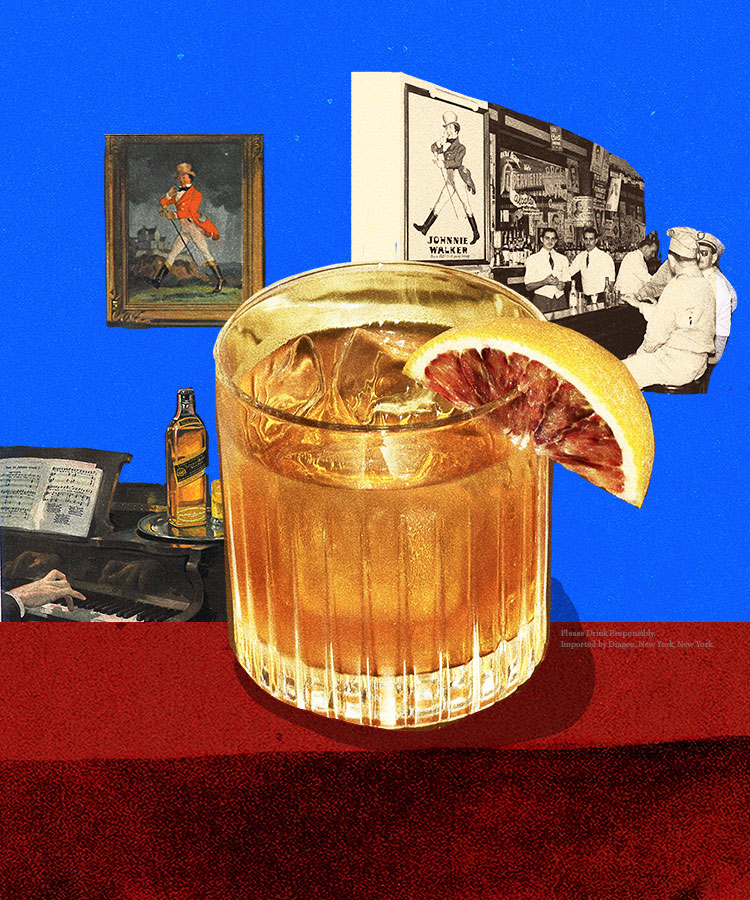
This article is part of a cocktail history series, sponsored by Johnnie Walker. Discover more about classic Scotch cocktails here!
The halls of cocktail history echo with renowned names like the Sazerac, the Martinez, and the Manhattan. But in terms of historic importance, nothing compares to the Old Fashioned. To drink one is to taste the original, primordial cocktail, one that’s largely still made according to the oldest known cocktail recipe, dating from the first decade of the 19th century.
Back then, of course, a cocktail wasn’t “old-fashioned” so much as it was “new-fangled,” and thus generally unknown — and strange enough to inspire a reader to request an explanation from an upstate New York newspaper editor. In the May 13, 1806, issue of The Balance and Columbian Repository, Harry Croswell answered a reader’s query from the previous week, defining a cocktail for all posterity as “a stimulating liquor, composed of spirits of any kind, sugar, water and bitters.” Aside from the missing orange peel, most drinkers will recognize that list as a blueprint for what we now call an Old Fashioned.
The drink wouldn’t earn that particular name, however, for several decades. With the arrival of newly imported liqueurs and spirits in the mid-19th century, bartenders started creating dozens of new recipes, as described by Jerry Thomas in “The Bar-Tender’s Guide,” whose 1862 edition includes then-innovative drinks like the Brandy Crusta and the Crimean Cup. That book also includes an “old-fashioned” gin cocktail, made with just spirits, sugar, water, and bitters. As more and more “improved” and “modern” cocktails were being dressed up with newly available liqueurs and enhancers like curaçao, Maraschino, and absinthe, old-timers and traditionalists kept requesting “old-fashioned” versions. Their pleas for simpler concoctions eventually turned into a recipe itself.
After repeatedly going in and out of style, the Old Fashioned is once again extremely popular. Though the base spirit can be almost anything (mezcal and aged rum are popular these days), brandy, bourbon, and rye are generally considered the most historically accurate. Technically, you can make an Old Fashioned with just about anything in your home bar. For a nuanced shift, consider making one with blended Scotch, which offers an elegant take on the classic that perfectly hits all of the traditional notes: Just like the original, a blended Scotch Old Fashioned is deliciously bitter, sweet, rich, and smoothly balanced. At the same time, blended Scotch presents unexpected — and delicious — new possibilities.
While clove-heavy, cinnamon-scented Angostura bitters are the traditional choice for a rye or bourbon Old Fashioned, the grassy, floral, salty, and smoky flavors of Scotch can give way to a different spectrum of bitters, including orange, lemon, and grapefruit, as well as a variety of sugars and sweeteners.
It’s not just the ingredients of the Scotch Old Fashioned that welcome variation: Temperatures can be reinterpreted as well. Because Scotch opens up so well at room temperature, you can even skip the ice in a Scotch Old Fashioned, building the drink with plain water — just like the original cocktail from 1806.
When it comes to garniture, feel free to go as heavy or light as you see fit. A “fruit salad” approach was widely popular in previous eras, and it’s still the way folks make the Old Fashioned in many regions today. A blended Scotch Old Fashioned works great with a simple pull of orange peel — flamed, if you’re feeling inspired, though there’s no need to gild the lily. When it comes to the most classic of all cocktails, simple elegance has worked for over 200 years.
Ingredients
- 1 1/2 ounces Johnnie Walker Black Label
- 1/2 ounce 1:1 simple syrup
- 2 dashes aromatic bitters
- Orange peel
Directions
- Combine ingredients in an ice-filled mixing glass and stir well.
- Serve in a tumbler over ice.
- Twist a piece of orange zest over the glass to release aromatic oils.
- Garnish with an orange peel.
This article is sponsored by Johnnie Walker. Keep walking.
![]()
